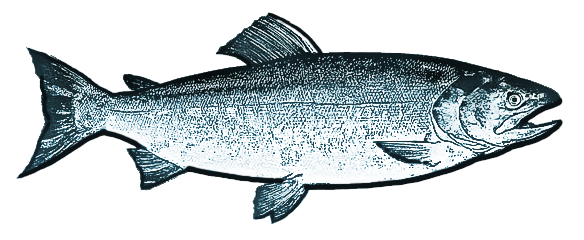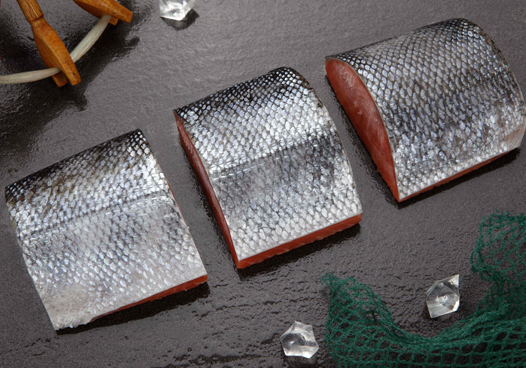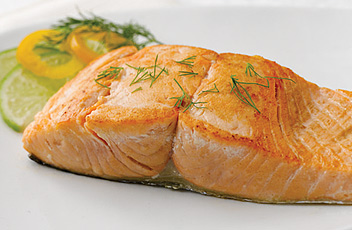Pink Salmon
Found on both sides of the North Pacific, from Alaska to Puget
Sound in Washington and from Russia to North Korea, pink
salmon are the most abundant Pacific salmon. They account
for almost half of the salmon harvested in Alaska and are well-
managed and stable.
They are the smallest of the Pacific salmon,
weighing between 3.5 and 5 pounds, with a length of 20 to 25".
Pink salmon's meat is more pale and lacks the orange tint
of the other salmon species; true to their name, their meat is
pink. Pink salmon is low in oil so it's generally lean and mild-
flavored. It has softer meat than most salmon and has a small
flake.
Pink salmon are primarily harvested in nets – both purse
seine and gillnets. Purse seiners catch salmon by encircling
them with a long net and drawing the bottom closed to capture
the fish. Gillnetters catch salmon by setting curtain-like nets
perpendicular to the migration direction along the coast toward
freshwater. The mesh openings on the nets are just large
enough to allow males (which are usually larger) to get stuck,
or gilled, in the mesh. Pink salmon are also caught incidentally
in commercial troll fisheries for chinook and coho salmon.
Fishing gear used to harvest salmon does not contact the
ocean floor so it doesn't impact habitat.
Like other Pacific salmon, pink salmon are anadromous –
they hatch in freshwater streams and rivers then migrate to the
ocean to feed and grow. Adults return to freshwater streams
to reproduce - usually in the stream of their birth. Pink salmon
are similar to chum salmon – they do not reside in freshwater
for an extended period like coho, chinook, or sockeye salmon.
Pink salmon feed on small crustaceans, zooplankton (tiny
floating animals), squid, and small fish. In freshwater, aquatic
invertebrates, other fishes, birds, and small mammals prey on
pink salmon eggs, alevins, and fry.
Pink salmon can be
distinguished fromother Pacific salmon by the large dark oval
spots on their back and entire tail fin as well as their general
coloring and form. In the sea, pink salmon are steel blue to
blue-green on the back, silver on the sides, and white on the
belly. Breeding males become dark on the back and red with
brownish green blotches on the sides. They also develop a
hump on their back, which is why they are often called
"humpy" salmon.
Sockeye Salmon
Sockeye, or red salmon, is the most valuable U.S. salmon
species. They're prized for their orange-red, rich-tasting meat
as well as their roe, which is used to make salmon caviar.
Sockeye salmon meat is firm and fatty, making it rich in omega-3
fatty acids. This also gives the meat a rich flavor, which is said
to rival the flavor of chinook (king) salmon. Sockeye salmon is
sold fresh, frozen, canned, and smoked. The largest harvest of
sockeye salmon in the world is in the Bristol Bay area of south-
western Alaska. Sockeye salmon are found on both sides of the
North Pacific Ocean and range from Point Hope in northwestern
Alaska to the Klamath River in Oregon and from the Anadyr River
area of Siberia southward to Hokkaido, Japan.
Like other Pacific salmon, most sockeye salmon are
anadromous – they hatch in freshwater streams and rivers, then
after 1 to 3 years they reach the smolt stage and migrate to the
ocean to feed and grow. Sockeye salmon typically mature and
return to freshwater after 2 to 3 years at sea, but some return
earlier or stay at sea longer, between 4 and 5 years. Sockeye
salmon that return earlier are almost always males and are
called "jacks." Sockeye salmon typically spawn in the summer
or fall. Eggs hatch during the winter, and the newly hatched
salmon (alevins) remain in the gravel, living off the material
stored in their yolk sacs until early spring. They then emerge
as fry and spend 1 to 3 years in freshwater before migrating
out to the
ocean, usually in the spring. All sockeye salmon die
within a few weeks after spawning. Sockeye salmon sexually
mature around the age of 5, which means their life span is
about 5 years, although some live longer.
Sockeye salmon
are one of the smaller species of Pacific salmon, measuring
1½ to 2½ feet in length and weighing 4 to 15 pounds.
As sockeye salmon return to their freshwater spawning
grounds, their heads turn green and their bodies turn bright red,
hence their other common name, "red" salmon. Males develop
a humped back and hooked jaws filled with tiny, visible teeth.
Sockeye salmon are primarily harvested commercially in net
fisheries – gillnet fisheries take the greatest number, but
sockeye salmon are also an important catch for purse seine
fisheries.Sockeye salmon are also caught incidentally in
commercial troll fisheries for chinook and coho salmon.
Chum Salmon
One of the lower-priced Pacific salmon at the market, chum
salmon populations can vary dramatically in abundance from
year to year.
Chum salmon has a lower oil content than other wild
salmon, so it has a relatively mild flavor and a meaty, firm
texture. Raw chum is orange, pink, or red and is more pale
than sockeye, coho, and chinook. The exact color of the meat
depends on where the fish was caught – their flesh becomes
progressively more pale and gray as chum migrate upstream
to spawn, and they are graded based on this. They also
become very easy to identify because of their watermarks –
the vertical bars/color bands along the sides of the fish.
The more mature and the closer
to freshwater the
salmon gets, the darker the color bands."Silver-bright" is the
commonly used term for top-quality ocean-run chum; the skin
on this fish is shiny silver and the flesh is reddish pink. Silver-
brights should not be confused with "silver salmon," which is
another name for coho. "Semi-bright" describes a more
mature fish
with watermarks that do not extend below the
lateral line (a faint line running lengthwise down each side
of the fish). Chum with watermarks extending below the
lateral line are commonly referred to as "dark"; the skin is
gray to black with occasional red mottling below the lateral
line. These fish will have soft meat that is not flavorful,
although it may be pink. While the low fat content of chum
salmon makes it the least desirable of the Pacific salmon for
canning, it is a preferred salmon species for smoke curing.
Chum salmon are also typically sold fresh or frozen.
Chum salmon are primarily harvested in net fisheries –
purse seine fisheries take the greatest number, but chum
salmon are also an important catch for gillnet fisheries.
Purse seiners catch salmon by encircling them with a long
net and drawing the bottom closed to capture the fish.
Gillnetters catch salmon by setting curtain-like nets
perpendicular to the migration direction along the
coast toward freshwater.
Atlantic Salmon
Atlantic salmon is the only salmon species native to the
Atlantic Ocean.
Once-healthy wild populations of Atlantic
salmon became devastated by industrialization and dam
construction along rivers in the northeastern United States.
Farmed salmon tend to have high levels of healthy fat
(omega-3s) in them, which makes them a very healthy fish
to consume. Both U.S. hatchery-raised and wild-caught
Pacific salmon and farmed Atlantic salmon are sustainable
options for consumers to purchase.
Consumption of marine
omega-3 fatty acids has been shown to prevent and aid in
the treatment of many clinical ailments including high blood
pressure, heart disease, certain types of cancer, clinical
depression, anxiety, and macular degeneration.
Most farmed salmon are grown principally in net pens.
Enclosed cages are submerged into aquatic environments;
careful protocols and monitoring help minimize nteractions
with the environment. More than 1.4 million tons of farmed
Atlantic salmon is produced worldwide, making up more
than 50 percent of the global salmon market, with the
majority of farmed Atlantic salmon coming from Canada,
Chile, Norway, and other European countries.
Fish farming, including salmon farming, is one of the most
resource-efficient ways to produce protein compared to other
forms of animal food production. Feed conversion ratios (the
amount of feed eaten by a fish relative to the amount that fish
provides for human consumption) vary among species, but
farmed fish are generally far more efficient at converting feed
than wild fish and many terrestrial animals such as cows
and pigs.
Atlantic salmon have a spindle-like body shape—
rounded, broad in the middle, and tapered at each end. The
shape is somewhat flattened toward the sides, which is typical
of salmon species. The head is relatively small, about one-fifth
of the body length. The ventral (underside) paired fins are
prominent, especially on juveniles.
Fillet
All varieties
Steaks
Pink, Chum
Portions (entrée)
Pink, Chum, Atlantic
Portions (pre-cuts) Pink, Sockeye, Chum
Blocks (whole fillet, minced, bits/piece)
Pink, Chum
Value added (Pink/Chum):
Batter coated Fish 'n Sticks (wild catch salmon 1 oz./2 oz.)
Cedar planked Salmon
Value added (Sockeye/Atlantic):
Cedar planked Salmon
Chang Versions Offered
Remember one fundamental rule when cooking salmon:
Low and Slow!!
Keeping the heat low, and extending the
cooking time is the ideal cooking
method to preserve the
moist succulent flesh.
Salmon is one of the most versatile
finfish in the
world, able to stand up to both mild and
medium
sauces (always applied with a very light hand).
Slow, low heat steaming of salt-brined salmon is a favorite
preparation
method, but salmon also takes well to lower
temperature
baking, broiling, frying, roasting, serving en
pappiote, pan -frying,
grilling (flat-top), grilling (bbq), and
a Native American
traditional preparation cooking
method, Cedar Plank cooking.
Seared Wild Alaskan Salmon – courtesy of ASMI

Pink Salmon:
- Serving Size 100 g
- Calories 116
- Calories from Fat 32
- Total Fat 3.5g 5%
- Saturated Fat 0.6g 3%
- Cholesterol 45mg 15%
- Sodium 67mg 3%
- Protein 19.9g
- Total lipid (fat) 3.5 g
- Iron .77mg
- Potassium K 323 mg
- Sodium .67mg
- Fatty acids 0.6g

Sockeye Salmon:
- Serving Size 100 g
- Calories 82
- Calories from Fat 5
- Total Fat 0.6g
- Saturated Fat 0.6g 1%
- Monounsaturated Fat 37.0g
- Sodium 71mg 3%
- Protein 17.9g
- Total lipid (fat) 0.6g
- Iron .3mg
- Potassium K 403 mg
- Sodium .71mg
- Fatty acids, saturated 0.1g
- Fatty acids, unsaturated 37g

Chum Salmon:
- Serving Size 100 g
- Calories 82
- Calories from Fat 5
- Total Fat 0.g
- Saturated Fat 0.6g 1%
- Monounsaturated Fat 37.0g
- Sodium 71mg 3%
- Protein 17.9g
- Total lipid (fat) 0.6g
- Iron .3mg
- Potassium K 403 mg
- Sodium .71mg
- Fatty acids, saturated 0.1g
- Fatty acids, unsaturated 37g

Atlantic Salmon:
- Serving Size 140 g
- Calories 330
- Calories from Fat 162
- Total Fat 18.0g 28%
- Saturated Fat 4.6g 23%
- Cholesterol 69mg 23%
- Sodium 107mg 4%
- Protein 33.0g
- Total lipid (fat) 18g
- Polyunsaturated Fat 6.9g
- Monounsaturated Fat 5.7g
- Potassium 167mg















